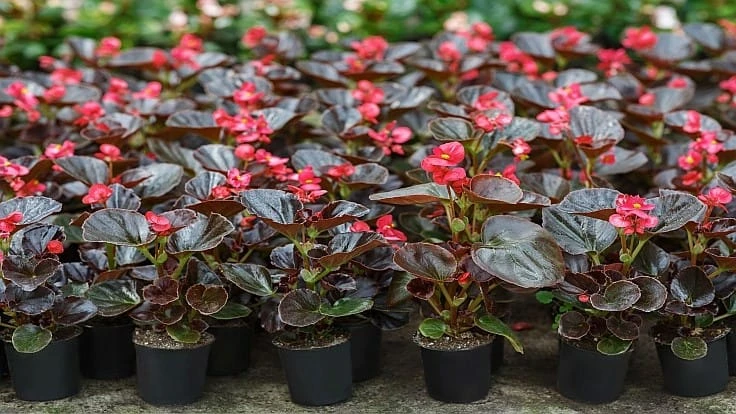
Photo Credit Adobe Stock
Begonias were originally farmed in Africa, close to the equator where very little day length change occurs.
If you’re growing begonia varieties in the greenhouse, there are several production best practices you should be aware of to ensure success with the crop. Plantpeddler’s Mike Gooder went over his top tips during a session at AmericanHort’s recent Finished Plant Conference.
“Stress management is the key with this plant. If you take home any message from this presentation, I’d want it to be to focus on stress management,” Gooder told attendees.
Specifically, he said to reduce stress early in the plants’ life cycle to get more vegetative growth initially, and then to induce stress to get them to flower.
“Once they leave your propagation area, no more [supplemental] lighting,” he added. “And then you want to pull back on the stress as they finish up.”
Gooder has also uncovered the ideal planting manner for begonias. He said that since begonias have a front and back, it is important to plant them back-to-back, and you should always turn young cuttings to all face one direction, backs together with two fingers worth of spacing between them when planting in trays.
On the subject of pinching, he was quite clear: Don’t do it.
“No, you’re going to add a whole bunch of time onto the production cycle [if you pinch], and you lose uniformity in flowering; you do not need to pinch,” Gooder advised. “And if your begonias stretch, bury them. Don’t fear planting them too deep — you’ll get branching below the soil line and you want to have stability in the pot, and this will give it to you.”
As far as climate conditions in the greenhouse, Gooder said you “can’t cheat the heat” with begonias.
“Begonias need every bit of love — they want to feel warmth, be coddled, that sort of thing,” he explained. “You want a soft environment with high humidity, and average temps in the 70s.”
“The biggest problem I see is people that cheat the heat on this crop,” Gooder added. “Once the outside temperature starts to dip, then you induce flowering. But run them in vegetative at at least 75-78 degrees F. You might even run them in the low 80s because it’s a tropical plant. This is not to be grown with petunia in a 55-degree block.”
Gooder and his team at Plantpeddler also highly recommend night interruption or day length extension, saying that either one will suffice. And you want to plant this crop later in the spring so you can take advantage of the naturally longer days and warm greenhouses.
As far as fertility recommendations, Gooder and co. run what he called a gentle, ammonia-based feed at around 250 ppm.
“Begonias are all water, so if you want a bigger begonia, just add more water,” he added, noting the crop is not a heavy feeder in vegetative (stage) or in flower. “Want a smaller plant? Add less water.”
And once you’re ready to start finishing begonias, Gooder said it’s simple: you increase watering frequency and reduce the ppm levels of your feed (to around 100-150 ppm) while also switching from ammonia to calcium-based nutrients.
As to common production challenges with begonias, Gooder says his team will occasionally battle premature budding, flowers that are too small and powdery mildew. Managing the growing environment, staying on top of sanitation, and monitoring EC will go a long way in alleviating most of those concerns, he said.
Latest from Greenhouse Management
- Anthura acquires Bromelia assets from Corn. Bak in Netherlands
- Top 10 stories for National Poinsettia Day
- Langendoen Mechanical hosts open house to showcase new greenhouse build
- Conor Foy joins EHR's national sales team
- Pantone announces its 2026 Color of the Year
- Syngenta granted federal registration for Trefinti nematicide/fungicide in ornamental market
- A legacy of influence
- HILA 2025 video highlights: John Gaydos of Proven Winners





